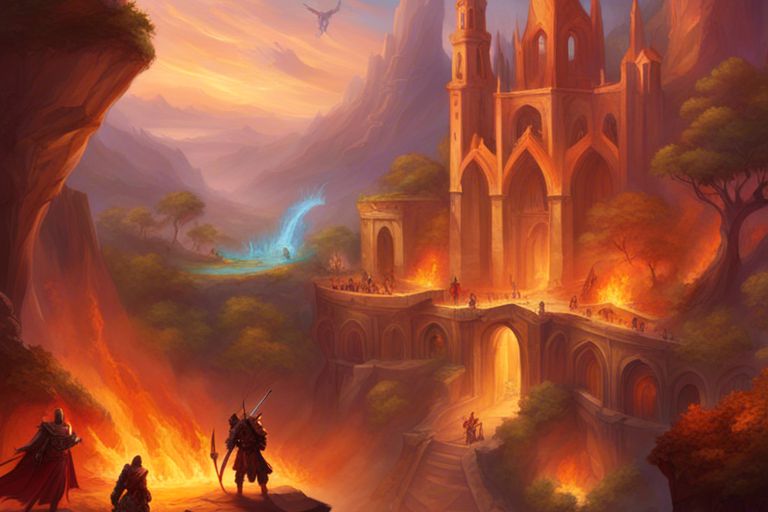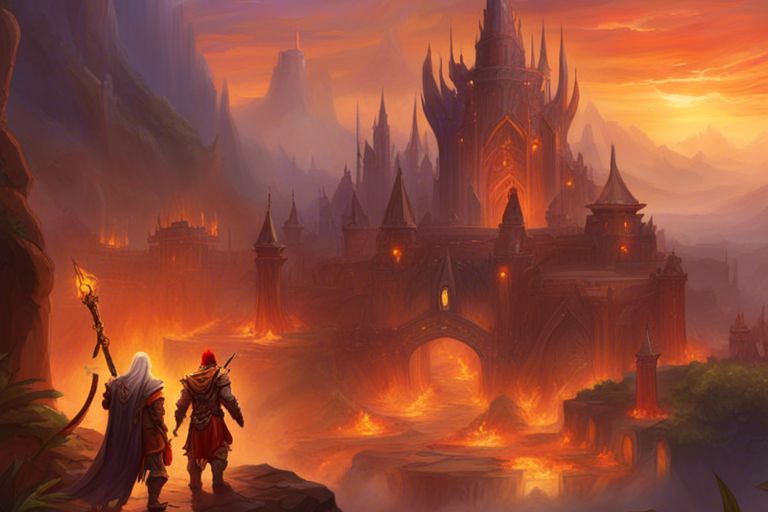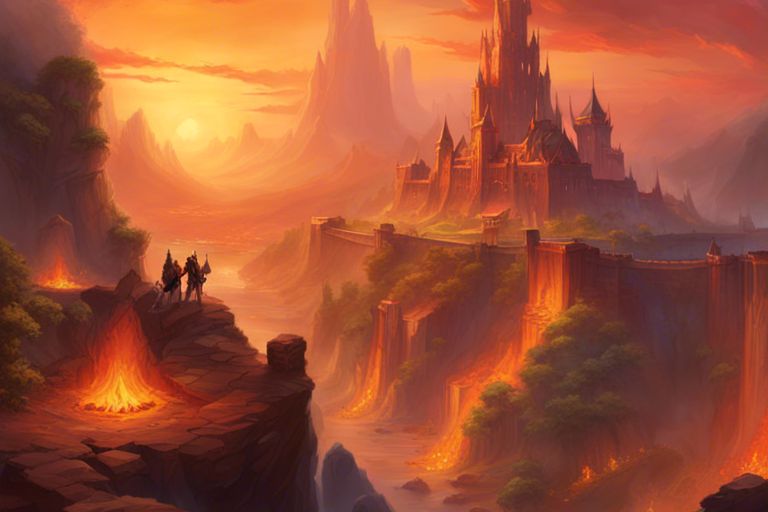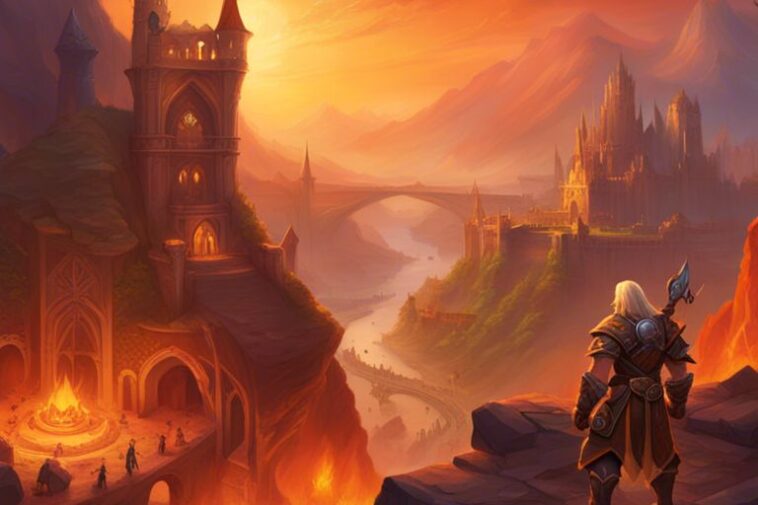You will discover how pivotal dungeons are to your journey in Vanilla World of Warcraft, transforming your gameplay and offering unique experiences filled with challenges, loot, and lore. This guide provides an in-depth look at each dungeon, from the fiery depths of Ragefire Chasm to the haunted halls of Stratholme, detailing everything from layout and navigation to the most fearsome bosses you’ll encounter. Prepare to dive deep into the heart of WoW’s rich dungeon ecosystem and enhance your adventure through Azeroth.
Overview of Vanilla WoW Dungeons
Before entering into the depths of each dungeon, it’s imperative to understand the framework that defines their structure and variety. Vanilla World of Warcraft, the original iteration of the iconic MMORPG, introduced players to a rich and expansive universe where adventures awaited around every corner. Within this vibrant world, dungeons served as critical venues for group content, challenging players to band together to defeat powerful foes, solve puzzles, and claim valuable loot. Each dungeon boasts its unique atmosphere and lore, enhancing the visual storytelling that ties the entire game together.
Types of Dungeons
On closer inspection, you’ll find that dungeons in Vanilla WoW are primarily categorized based on their level range and the challenges they present. Each dungeon attracts different groups of players at various stages of their journey, catering to both newcomers and seasoned adventurers. From the relatively straightforward layouts of early dungeons to the intricate designs found in more complex settings, these environments have been crafted with care to offer unique gameplay experiences.
| Type | Description |
| Linear Dungeons | Progressing through a straightforward path, often leading to a final boss. |
| Quest-Based Dungeons | Focus on achieving specific objectives, usually tied to quests. |
| Exploratory Dungeons | Encourage players to explore diverse environments, often containing multiple pathways. |
| Event-Driven Dungeons | Incorporate unique events or mechanics that require players to adjust their strategies. |
| Classic Dungeons | Form the backbone of the game, perfect for both casual and hardcore players. |
With such a variety of types, each dungeon can inspire different group dynamics and strategies. This wide array of dungeons allows you to experience the full breadth of the game and adapt to the needs of your party. Whether you prefer the direct confrontation of linear dungeons or the intricate exploration of the exploratory types, there’s a dungeon that suits your preferred play style.
Significance in Gameplay
If you consider the experience of adventuring within WoW, dungeons serve as critical milestones shaping your character’s development and your group’s cohesion. They provide a structured form of content that challenges your skills, coordination, and understanding of mechanics. More than just a battle against NPCs, dungeons often foster camaraderie among players, as they work together towards the shared goal of defeating formidable bosses and completing quests.
In addition to offering exciting gameplay, dungeons serve as imperative sources of loot, contributing to your character’s progression. The loot system incentivizes players to return to these locations time and again, searching for that elusive powerful item or crafting material. The allure of exploring these areas and uncovering powerful weaponry or gear creates a meaningful engagement loop that keeps players immersed in the game world.
Moreover, wise players will recognize that dungeons like Ragefire Chasm and Stratholme each provide a unique atmosphere and storytelling elements that are central to the lore of the game. From engaging battle scenarios to rich narratives, dungeons offer a vast landscape of experiences for players to engage with.
Key Features of Vanilla Dungeons
The key features that define Vanilla WoW dungeons contribute significantly to the overall experience. Dungeons introduce structured environments, providing a mix of combat, questing, and resource gathering within distinct themes. The incorporation of various enemy types and mechanics requires solid teamwork, strategy, and adaptability, initiating a rewarding level of complexity.
- Unique Boss Mechanics: Each boss offers distinct challenges that test your party’s abilities.
- Diverse Environments: Explore settings ranging from dark caverns to lush groves.
- Rich Lore: Each dungeon is steeped in stories that deepen your understanding of the world.
- Co-op Gameplay: Requires collaboration among players to succeed.
- Rewarding Loot Tables: Each run provides opportunities for valuable gear and resources.
Assume that you approach each dungeon not just as a challenge but as a journey filled with potential discoveries and trials. The variety and depth within these encounters should not be understated, as each adds a piece to the colossal puzzle that is your adventure in Azeroth.
To further enrich your understanding of what Vanilla dungeons have to offer, keep in mind that most of these dungeons create an environment that challenges your mental and strategic skills alongside your ability to communicate with your team. You will find that some dungeons are considered imperative for honing your skills and applying your character’s abilities effectively.
- Challenging Mechanics: Requires creative approaches and synergy with teammates.
- Variety of Loot: Different factions and bosses drop unique rewards.
- Interactive Elements: Many dungeons feature puzzles or traps to overcome.
- Atmospheric Design: Each dungeon is visually designed to immerse you in the experience.
- Community Engagement: Dungeons often form the basis of group play sessions, forging connections.
Assume that every encounter you face in these dungeons is an opportunity to grow both as a player and as part of a larger community. The immersive designs and layered gameplay mechanics make each dungeon worth exploring, as they enhance your overall experience in the vibrant world of Vanilla WoW.

Dungeon List and Rewards
List of Dungeons by Level Range
The dungeons in Vanilla World of Warcraft are not merely settings for combat; they represent unique experiences, each tailored to specific player levels and lore. Understanding the level range for each dungeon is crucial to optimize your adventures and ensure your party is neither overmatched nor underprepared. The iconic dungeons begin their journey from the fiery depths of Ragefire Chasm, designed for players between levels 13 to 18, and progress through a series of environments that showcase the game’s diverse world and intricate storytelling. You’ll find that each dungeon offers a distinct atmosphere and challenge, leading up to the more complex experiences awaiting you in the later stages, like Scholomance and Stratholme, which cater exclusively to those at level 58 to 60.
As you explore the list, you’ll see that each dungeon not only fits into a specific level range but also has a unique theme and structure. For instance, at level 17-24, Wailing Caverns invites players into its lush yet hazardous groves, while The Deadmines at level 17-26 takes you through the treacherous tunnels of a defunct goblin mine. The variety of dungeons allows for diverse gameplay experiences, whether you prefer slaying undead in Shadowfang Keep or exploring the mechanical wonders of Gnomeregan from level 29 to 38. With dungeons designed for both grouping and the occasional solo foray, you can expect every adventure to enrich your journey in Azeroth.
Finally, navigating from one dungeon to another introduces you not only to new enemies but also to distinct drops and lore elements. This progression, from the early levels of Ragefire Chasm to the foreboding depths of Blackrock Depths and ultimately to the chaotic remains of Stratholme, ensures that you’re engaged and challenged throughout your leveling experience. Each dungeon is intricately woven into the larger narrative of Vanilla WoW, and the encounters you face will often resonate with broader themes of conflict, struggle, and community.
Notable Loot Rewards
Some of the most exciting aspects of exploring dungeons in Vanilla WoW are the loot rewards that await you at the end of each run. These rewards range from valuable items that can significantly enhance your character’s capabilities to unique gear that can become a treasured part of your inventory. For instance, completing Ragefire Chasm can yield items such as the Emberstone Staff and various weapons that cater to specific class needs. Moving on to Wailing Caverns, you might be fortunate enough to acquire the Staff of the Prophets or some superior gloves that trigger your interest and complement your builds. This cycle of obtaining loot through dungeon crawling forms the backbone of your character’s progression.
As you journey towards the higher levels, dungeons like Scarlet Monastery and Maraudon provide gear that can define your gameplay style, such as the Fist of Omens or the Wand of the Watcher. The continuous pursuit of loot also serves as an excellent motivator for running these dungeons repeatedly, as many items offer unique stats and abilities that can profoundly affect your play experience. Unlocking the capabilities of your character through gear allows you not only to become more powerful but changes the way you approach future challenges and encounters.
With every dungeon providing unique loot rewards, there’s a satisfying sense of progression that awaits you. The thrill of discovering new gear—a piece that perfectly complements your play style or even a rare drop that you can show off to your friends—creates an exhilarating atmosphere. This loot system drives you to revisit dungeons, strategize with your group, and perhaps even discover new droppable items you hadn’t encountered before.
Recommended Strategies for Each Dungeon
Dungeon runs can often become chaotic, and having solid strategies for success can make all the difference. Each dungeon requires a different approach, characterized by its enemy types, layouts, and boss mechanics. For example, in Ragefire Chasm, effective crowd control can be critical due to the presence of groups of gnolls. Forming a balanced party composition with tanks, healers, and DPS will provide a stronger foundation for tackling encounters. As you investigate into the cooler climates of Shadowfang Keep, positioning becomes vital as many bosses have area of effect skills that can devastate uncoordinated groups, so sticking together and timing your cooldowns well is necessary.
As you progress through the levels, factions and lore also influence strategies; understanding the lore behind the dungeons may not only evoke immersive storytelling but also inform your approach to defeating the enemies you encounter. When dealing with powerful bosses in Scarlet Monastery, for instance, you must recognize which enemies need to go down first and coordinate your attacks accordingly. Effective communication within your party ensures that each member knows their role, whether it’s to soak damage, offer healing, or unleash maximum damage during critical moments.
Dungeons require not just individual skill but also cooperative tactics that can often be the difference between victory and defeat. As new mechanics are introduced with each challenge and as you face more complex encounters, your strategies need to adapt accordingly. Study up on dungeons before venturing into them, and take time to familiarize yourself with each boss’s mechanics and trash mob patterns for optimal runs.
Dungeons present unique opportunities for crafting effective tactics that can enhance your gameplay experience. With so many shifting variables in each environment—from the layout and enemy behavior to party composition—the way you approach each challenge plays a critical role in your success. This conscious incorporation of strategies ultimately leads to more enjoyable runs, allowing you to forge stronger connections with your teammates and truly immerse yourself in the world around you.
Tips for Navigating Dungeons
After you look into the world of Vanilla WoW dungeons, the key to a successful experience lies in preparation. Knowing how to navigate the intricacies of each dungeon will not only enhance your gameplay but also ensure that your party maintains a smooth flow throughout. Here are some important tips to keep in mind as you explore:
- Research each dungeon’s layout and mechanics before entering.
- Gather your gear and potions to maximize your effectiveness.
- Communicate with your team to set expectations for your run.
- Establish roles within your group for an organized approach.
- Stay alert for triggers, traps, and environmental hazards.
Recognizing the intricacies of each dungeon will help you fully enjoy the experience and master the challenges that lie ahead.
Preparation and Gear
Tips for navigating dungeons in Vanilla WoW start long before you enter the instanced zone. Preparation is crucial to your success. Before gathering your party, assess your gear and ensure you are equipped with items that match the recommended level of the dungeon you plan to tackle. Upgrading your gear through quests or crafting can significantly increase your chances of surviving against tougher enemies. Moreover, upgrading your gear often means obtaining better stats, thus enhancing your overall performance during fights. Don’t forget to stock up on consumables, especially health potions and mana potions, which can be lifesavers in critical battles.
Moreover, consider the attributes synergistic to your role. If you are a tank, focus on items with high stamina and armor ratings, while healers should prioritize gear that boosts intellect or spirit for maintaining mana and survivability. DPS classes must strike a balance between maximizing their damage output and ensuring they are equipped to survive in group encounters. Conducting a gear audit before you form a party will help each member to contribute meaningfully to the group’s overall effectiveness in battle.
Lastly, always take the time to prepare your character for the challenges they may encounter within the dungeon. This includes adjusting your talents or skills according to the fight mechanics and ensuring you have the necessary buffs active. Whether it’s a food buff, a spell, or an enchantment, tailored adjustments to your character can significantly turn the tide in challenging encounters. The more effort you put into preparation, the smoother your dungeon journey will be.
Group Composition and Roles
Group composition is pivotal when venturing into anything from Ragefire Chasm to the challenging depths of Stratholme. Successfully completing a dungeon requires a balanced group with well-defined roles. Ideally, your party should consist of a strong tank, a dedicated healer, and several DPS characters. This triangle of roles ensures that the tank can absorb damage, the healer can keep everyone alive, and the DPS can eliminate threats as they arise. Understanding and embracing your role is crucial in achieving your objective and pushing through tougher encounters.
Group synergy is also highly beneficial. Certain classes can complement each other with powerful combinations, enhancing your overall effectiveness. For example, a combination of a Warrior Tank alongside a Paladin Healer can create a formidable frontline, while adding classes like Mages or Hunters can ensure that damage output stays high. It’s also beneficial for parties to have at least one member who can dispell or interrupt spells, as you may encounter enemies with debilitating abilities that require quick reactions. Developing synergy among your roles and character builds can lead to a much smoother run.
To maximize your dungeon experience, you should also consider forming groups based on your skills and personalities. Having players who understand their class mechanisms and can adapt to unexpected situations will inevitably improve your team’s performance. Communicate your preferences and constraints with the team, helping to create a cohesive unit that can tackle the challenges head-on.
Communication and Coordination
Any successful dungeon run hinges on effective communication and coordination among team members. Open lines of communication will allow your group to discuss strategy, warn each other of impending dangers, and address issues as they arise during the run. This may involve discussing your approach to specific boss encounters or determining the most efficient method for dispatching trash mobs without drawing unwanted attention. Establish a system for calling out targets, especially during boss fights, where coordinated focus fire can mean the difference between defeat and victory.
Additionally, it’s crucial to ensure that everyone knows their role for each encounter. A well-informed party, where members understand when to use their abilities, can execute strategies effectively. This includes pre-empting mechanics, utilizing cooldowns at the right moments, and managing your resources wisely through effective communication. Make it a habit of calling out when a cooldown is available or when a health potion has been consumed, as this increases your chance of survival.
Communication should also extend to the pre-dungeon phase and after the run. Discussing your strategies before entering the dungeon allows everyone to be on the same page, and a post-dungeon debrief can help identify what went wrong or what could be improved for future runs. By building a rapport with your party, you will nurture a collaborative environment that fosters personal growth and camaraderie among players. Ultimately, this enhances your overall dungeon navigation experience in the vast landscape of Vanilla WoW.

Detailed Dungeon Guides
Ragefire Chasm
Many adventurers launching upon their journey through Vanilla WoW will find themselves navigating the treacherous paths of Ragefire Chasm, located beneath the bustling city of Orgrimmar. This dungeon serves as a critical starting point for players, particularly those at levels 13 to 18, as it immerses you in a theme that carries the weight of both the Orcish and the Tauren hegemony. Here, the scorching flames and the grueling layout echo the stories of early server clashes and set a tone for the adventures to come.
Assuming you investigate into this dungeon, your path is filled with unique features that define its layout. Ragefire Chasm boasts a fairly linear design but incorporates a series of winding corridors that can lead to unexpected challenges. You’ll encounter various trash mobs that lend texture to the experience, including the fierce and fearsome Burning Blade cultists, who guard the secrets of the chasm vehemently. The shorter run time and direct navigation make it a perfect first dungeon where you can practice your coordination and party synergy.
Moreover, the replayability factor is underscored by the potential loot that drops from the bosses within. Though you’re traversing familiar pathways, each run can yield significantly different experiences; the challenge levels rise based on your team composition and preparations. With two boss encounters, you face not only the challenges of navigating the dungeon but also those of mastering the mechanics that accompany each fight. Completing Ragefire Chasm is not just about loot; it represents a rite of passage for many players entering the world of Azeroth.
Wailing Caverns
Chasm’s haunting beauty captivates adventurers as they step into the serene yet eerie environment of the Wailing Caverns, a dungeon suited for players between levels 17 to 24. Nestled in the heart of the Barrens, this dungeon is unlike others in that its design closely mimics a vast underground botanical garden, dominated by twisting vines and shimmering waters. The ambiance evokes both serenity and danger, drawing you deeper into the story of the corrupted druid, Naralex.
As you navigate through these winding paths, you will soon realize that despite its beauty, Wailing Caverns is a maze—a design choice that makes memorization and communication vital among your party. This complexity ensures that even when you think you’ve mastered the layout, you might still find yourself lost in the verdant expanse. Many players find the engagement with the dungeon’s naturalistic theme to be rewarding, and it encourages exploration, evoking a nostalgic sense of adventure.
Caverns present a wide array of challenge levels, with numerous trash mobs interspersed throughout that keep the content fresh. With enemies like the Thornweavers and other corrupted wildlife, you’ll need healing and crowd control to prevail as a team. Not only does this dungeon allow you to gear up with some solid loot, but it also serves as a great place for new players to hone their skills before they advance to more formidable instances.
The Deadmines
Navigation of the Deadmines can indeed be one of the most engaging early experiences as you progress through the levels of 17 to 26. Set within the rocky cliffs of Westfall, this dungeon tells the tale of the defiant undead miners while presenting a well-constructed layout that encourages both vertical exploration and strategic combat engagements. You’ll traverse through tight corridors and open spaces, leading you to various encounters that tell the larger story of the Defias Brotherhood.
Your exploration of the Deadmines not only rewards you with solid gear but also immerses you in rich lore. Accessibility into the dungeon is reasonably straightforward, as it lies within Westfall, enabling players to easily gather groups and head in. Expect to face both humanoid enemies that require tactical engagements and larger mobs that bring an array of spells and abilities that will test your role within the team.
Accessibility here is enhanced by strong quest integration; many players will find themselves naturally drawn to this dungeon as part of their leveling path. With multi-stage fights, including confrontations with the infamous VanCleef and his loyal followers, The Deadmines stands as a pivotal questing ground for newcomers and veterans alike. Skillfully tackling this dungeon deepens your appreciation for the intricate designs of WoW’s narrative experiences.
Shadowfang Keep
Step by Step, you’ll find your way through the dark corridors and cavernous rooms of Shadowfang Keep, a dungeon perfect for players ranging from levels 22 to 30. Located in Silverpine Forest, Shadowfang Keep is steeped in Gothic lore, serving as the bastion of the wraiths and their sinister leader, Baron Silverlaine. This dungeon’s hidden pathways and shadow-laden environments convey an unmistakable aura of mystery and danger, challenging your party’s cohesion as you confront unexpected ambushes.
The stages of Shadowfang Keep unveil a complex level design that promises a unique approach to each room. Battle your way through powerful trash mobs, including tormented spirits and feral worgs, that test your agility and preparedness. The varying heights and narrow passages will keep you on your toes, ensuring that each attempt feels fresh and exciting. Furthermore, grasping the mechanics around the bosses, such as getting the timing right during the Baron’s waves of attack, is critical to ensuring your team progresses without major setbacks.
A particularly noteworthy challenge occurs during the boss fights where teamwork is paramount. You’ll face several formidable foes who each bring unique mechanics that require learning and strategy. With the reputation rewards from successfully completing this dungeon, Shadowfang Keep stands tall as a favorite encounter among players looking for loot and victory.
Blackfathom Deeps
Navigation within the Blackfathom Deeps can be both thrilling and disorientating for you as a player. Set beneath the seas of Ashenvale, this dungeon combines elements of water-themed architecture with dreadful tales of the Naga and the Twilight’s Hammer clan. As you descend into the depths, you’ll face a mix of aquatic creatures and cultists that keep the encounters fresh and varied, necessitating a balance of damage, healing, and debuff management to conquer the challenges within.
Deadmines offer a beautifully crafted environment that encourages both exploration and critical thinking as you map out your path. The myriad of pathways can lead to both treasures and ambushes, requiring you to stay alert and reactive throughout your runs. Each room has its own allure, offering players chances to pick up unique and powerful loot while also unraveling the twisted tales that haunt the depths of Blackfathom.
Replayability Factors
Despite the vast content available in Vanilla World of Warcraft, the replayability of dungeons is a crucial aspect that keeps players engaged long after their initial completion. Various factors contribute to whether you’ll want to return to a dungeon repeatedly, making each excursion feel fresh and rewarding. Among these factors, unique mechanics, environmental diversity, and loot variability lay the groundwork for a compelling experience. Understanding these factors can enhance your overall gameplay, allowing you to maximize your time in Azeroth.
- Unique Mechanics
- Environmental Diversity
- Loot Variability
Unique Mechanics
Replayability hinges significantly on the unique mechanics that dungeons offer. These mechanics often pertain to the special attributes of bosses and trash mobs that require specific strategies to overcome. For instance, in dungeons like **Shadowfang Keep**, you might encounter mechanics that involve positioning, crowd control, and target switching. These elements force you to adapt your approach with each run, making it necessary for you to coordinate with your group dynamically. The combination of strategy and skill adds an exciting layer, keeping the experience feeling fresh each time you research into the depths of a dungeon.
Another aspect of unique mechanics is the adaptive difficulty you may face. Many dungeons feature bosses that utilize mechanics requiring quick reflexes or precise timing to avoid devastating abilities. For example, if you return to **Zul’Farrak**, the mechanics involving the boss battles evolve as you and your party members level up and improve gear. This can lead to a varied experience for seasoned adventurers versus those just breaking into the bracket. Consequently, even though you may know the layout, the need to constantly adapt to such challenges ensures that your interest remains piqued.
Furthermore, some dungeons incorporate random events or mob respawns that shift each experience from the last. This can mean encountering different enemy compositions or bonus mobs that appear under certain conditions. Such features augment the gameplay by ensuring that no two runs—the experience you share with your party—are ever the same. As a result, the combination of adaptive difficulty and event variations lays a strong foundation for replayability that transcends mere dungeon crawling.
Environmental Diversity
There’s no denying that the environmental diversity found within Vanilla WoW’s dungeons offers an incredibly rich visual and thematic tapestry. Each dungeon is often designed with a distinct aesthetic and atmosphere, transporting you into various realms—be it the eerie tunnels of **Ragefire Chasm** or the sunken ruins of **The Sunken Temple**. This variety not only makes each dungeon feel unique but also creates a certain excitement around returning to explore the different settings and lore that each one presents.
Atmospheric elements, like lighting, soundscapes, and visual design, contribute significantly to how dungeons feel to you and your party. A run through the mist-laden **Maraudon** brings not just challenges but the visual allure of its vibrant environments and rich lore surrounding the **Centaur** and **Earth Elemental** encounters. Each corner of a dungeon can feel like a distinct adventure in its own right, which is vital in a game where immersion plays a significant role. Environments that captivate your imagination encourage repeated visits as you wish to uncover every last detail.
Additionally, the gameplay intricacies tied to the environments often require strategic navigation or manipulation of terrain to outsmart enemies, further adding excitement to your expeditions. For instance, the **Gnomeregan** dungeon challenges you with obstacles that force you to employ verticality and movement to gain advantages during fights. Such features not only alter your approach but also make traversing each dungeon less of a grind and more of an evolving journey. You’ll find that a varied environment simply enriches your experience in a way that feels rewarding each time you explore.
Another factor contributing to the dungeon experience is the environmental storytelling laced throughout the dungeons. Each locale teems with visual clues and lore indicative of its history, enhancing your connection to the game. This strong narrative element motivates many players to return and dive deeper into the stories told, whether it’s through exploring hidden areas or discovering easter eggs left by the developers.
Loot Variability
You can’t discuss replayability in Vanilla WoW without mentioning the allure of loot variability. Dungeons are notorious for dropping sought-after gear, crafting materials, and unique items that are vital for your character progression. For players, there’s always the underlying hope that on your next run through **Blackrock Depths**, you’ll finally loot that coveted piece of gear you’ve been after—a hope that keeps you coming back week after week.
The randomness inherent in loot distribution enhances the excitement of every dungeon run. Each boss and treasure chest might yield different rewards, leading to each experience feeling like a gamble. You could walk away with something extraordinary—or simply vendor trash. This aspect taps into your innate desire to collect and compete, encouraging not just the grind but also camaraderie as you strategize with your group on optimal farm runs based on loot drops.
This variability ensures that no item is ever truly ‘safe’ from becoming a hot topic in your guild or party chat. Whether it’s the thrill of potentially acquiring a highly-demanded weapon or the rare enchantment recipe known to drop from a particular boss, the chance of changing your gear setup itself becomes a driving force behind your adventures. Players continually return to see if luck—with a bit of dungeon mastery—will be on their side for that sweet loot drop, ensuring that every trip into the depths remains uniquely fulfilling.
As with every aspect of a run, the variability of loot keeps your inventory full of surprises. Each run becomes more than just a quest for experience points; it morphs into a thrilling adventure of discovery.

Pros and Cons of Each Dungeon
For players venturing into the world of Vanilla WoW, understanding the strengths and weaknesses of each dungeon can significantly enhance your experience. Each dungeon presents unique challenges and rewards, making them memorable in their own right. Below, you will find a comparison of the major dungeons encountered from Ragefire Chasm to Stratholme, encapsulating what makes them stand out and what you might find less appealing.
| Pros | Cons |
|---|---|
| Varied atmospheres and lore-driven themes | Some dungeons can feel repetitive on subsequent runs |
| Challenging boss mechanics that require strategy | Difficulty spikes can lead to frustrating experiences |
| Excellent loot rewards, especially at higher levels | Entrance requirements and level restrictions can limit accessibility |
| Encourages group play and social interactions | Potential for toxic behavior in low-level runs |
| Replayability due to different class synergies | Some dungeons have long run times, which can lead to time investment |
| Rich history and nostalgia for veteran players | Inconsistent party composition can lead to challenges |
| Unique enemy types and mechanics | Learning curve for new players unfamiliar with dungeon layouts |
| Offers an avenue for character progression | Travel time can be lengthy between dungeons |
| Distinct cartography adds to the exploratory experience | Certain boss fights may require extensive gear optimization |
| Engaging environments enhance immersion | Prevalent class imbalances in lower-level dungeons |
Strengths and Weaknesses
Even though each dungeon in Vanilla WoW has its own set of challenges, the strengths often outweigh the weaknesses. Many dungeons serve as a gateway to lore-rich storytelling and offer environments that are both engaging and visually distinct. For example, dungeons like the Wailing Caverns and Scarlet Monastery not only offer challenges in enemy mechanics but also provide rich backstory and a vibrant setting that immerses you in the game. This emphasis on lore creates a sense of purpose, encouraging you to research deeper into the narratives woven into the game world.
On the flip side, some dungeons may feel tedious after multiple runs. The Deadmines and Gnomeregan are beloved by many, but their repetitive structure can lead to a feeling of monotony, especially if you’re hoping for a quicker dungeon crawl. Additionally, the potential for spikes in difficulty can make certain runs frustrating, particularly if your group composition is less than ideal. Encountering overwhelming enemy health or mechanics the group isn’t equipped to handle can quickly dampen your spirits.
Ultimately, the unique strengths and weaknesses of each dungeon contribute to a nuanced experience that rewards players for their effort. Engaging with various dungeon layouts enhances your strategic thinking, and learning from failures encourages gameplay improvement. While certain frustrations are inherent to the design, these challenges are also what forge camaraderie among players, making dungeon runs more than just simple quests, but adventures in teamwork and skill.
Recommended Group Sizes
Pros often recommend coordinating with a group size that complements the difficulty of the dungeons you are tackling. For many mid-level dungeons, a group of 5 players typically strikes the right balance between challenge and manageability. Larger groups can enhance damage output and survivability but can also invite complications that may hinder your overall efficiency.
The best practice is to adjust your party size based on the dungeon’s complexity and the experience level of your group. Some dungeons, like Razorfen Kraul and Scarlet Monastery, were designed with five players in mind and will yield optimal results when played with this number. However, it’s crucial to factor in the synergy among players; a well-coordinated group can tackle challenges more efficiently, regardless of size. On the other hand, soloing certain dungeons may be feasible with a well-geared player, though it can also be significantly more challenging and less enjoyable for the unprepared.
Experience Level Considerations
With each dungeon accommodating different level ranges, you must gauge your party’s experience against the challenges posed by the specific dungeon. Understanding the recommended levels not only improves your chances of success but also enhances your overall experience. Dungeons like Blackfathom Deeps or Zul’Farrak can be a rewarding challenge for appropriately geared parties, providing powerful loot but also requiring strong coordination and knowledge of mechanics.
Moreover, dungeons on the lower end of the level spectrum, like Ragefire Chasm, may serve as a great introduction for newer players to be eased into the mechanics of dungeon gameplay. Encountering enemy types and learning the importance of class roles allows you to build confidence for tackling tougher challenges down the line, like Scholomance or Stratholme. The learning curve may be steep, but successfully navigating more challenging dungeons is one of the more fulfilling aspects of gameplay.
Plus, it’s crucial to remember that experience is a two-way street; you’ll learn just as much from your teammates as they will from you. Each run can present opportunities for knowledge sharing, which improves not only your individual gameplay but also the overall group synergy. By harnessing each experience, you contribute to creating a more cohesive and skilled team, making future dungeon runs more enjoyable and rewarding.
Final Words
Conclusively, your journey through the diverse dungeons of Vanilla World of Warcraft, from the fiery depths of Ragefire Chasm to the haunting halls of Stratholme, invites you to explore the rich tapestry of lore, combat, and camaraderie that defines this iconic MMORPG. Each dungeon offers a unique challenge and an intricate design that not only tests your skills but also immerses you in the game’s expansive narrative. By understanding the complexity of dungeon layouts, the strategic elements they introduce, and the variety of enemies you may encounter, you enhance your potential for success. This comprehensive examination of Vanilla WoW’s dungeons serves as a robust guide as you navigate your path through Azeroth, pushing past the limits of your character while forging lasting memories with your fellow adventurers.
As you investigate deeper into these dungeons, consider the factors that contribute to their replayability. Whether it’s the pursuit of rare loot, the thrill of mastering boss mechanics, or simply the nostalgia of reliving epic moments, each dungeon holds its unique allure that beckons you back time and again. By comparing various dungeons and evaluating what makes each one special to you, you can tailor your gameplay experience and discover which challenges resonate most. Engaging with this classic content not only broadens your understanding of the game but also enriches your overall WoW experience, allowing you to fine-tune your approach based on your personal preferences and playstyle.
Lastly, as you reflect on your own adventures, don’t hesitate to join the collective conversation surrounding your favorite dungeons. Sharing insights and experiences can enhance not only your enjoyment but also provide valuable perspectives to your fellow players. Consider exploring community forums or engaging in discussions, such as What dungeon do you look forward to replaying once…, to hear other players’ stories and strategies. Ultimately, the legacy of Vanilla WoW dungeons will continue to thrive through these shared experiences, creating a vibrant tapestry of communal gameplay that you can cherish well into the future.




